| |
| |
Photographer,
Location |
Images |
Comments |
|
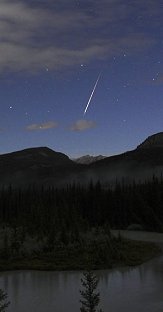
|
Yuichi
Takasaka,
Bow Valley, Banff National Park, Alberta, Canada
Aug. 12, 2009 |
#1,
more |
Most
of British Columbia was cloudy and/or rainy so I decided
to drive to Alberta to watch Perseids. It was cloudy when
I arrived to Banff National Park, but the sky opened up
some part of the night. This image was taken at 04:36 Mountain
Time.
Photo
details: Canon
5D MarkII, EF24/1.4L MarkII |
|
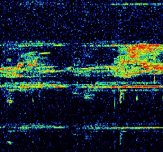
|
Jehin
Emmanuel,
Spa, Belgium
Aug. 12, 2009 |
#1,
#2,
more |
We
saw only a few meteors during the night August 11-12, but
we could "hear" a lot of them (about 4 per minute - image1)
thanks to the Groupe Astronomie de Spa (Belgium) Yagi antenna,
listening to a distant Russian TV channel at 49.76 Mhz.
The echoes are produced when the TV signal is bouncing off
the meteor's ionized tail and is then captured by the antenna.
This image is a computer jpeg record (using SpectrumLab
software) of the meteor signals (short vertical streaks)
in frequency space spanning 5 minutes around 01:22UT August
12. The 2d image is a similar record around 07:57 UT August
12 when the number of very strong meteors (overdense meteors
as "big blobs") suddenly increased (from ~1 bright every
5 minutes to ~1 per minute) for about 45 minutes. |
|
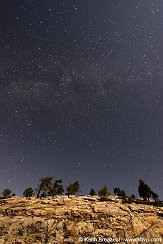
|
Keith
Breazeal,
The California Sierra Nevada Mountains just south of Lake
Tahoe at the 7,500 foot elevation.
Aug. 11, 2009 |
#1 |
High
in the California Sierra Nevada Mountains the sky is spectacular.
Even with the moonlight, the Perseids were visible to the
north. In this super wide field photo, the Milky Way provides
a dramatic backdrop for the Perseids. This 90 second exposure
captures the landscape as if were daylight and brings out
the beautiful night sky. The Perseid in this photo was one
of the nights best and brightest displays. |
|
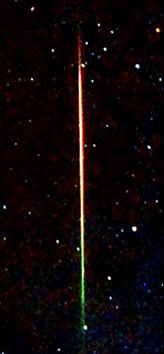
|
Don
Oberbeck,
Boulder, Colorado
Aug. 12, 2009 |
#1 |
Photo
details: 2:03 am MDT, August 12. 30 sec. exposure,
ISO 800, f/4. |
|
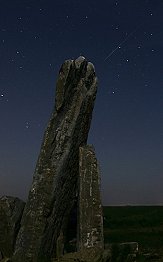
|
Kyle
Gerstner,
Cassoday, Kansas
Sep. 12, 2009 |
#1,
more |
Teter
rock in the Flint Hills of Kansas. Taken with a Canon Mark
2 with a 16/35mm 2.8f lens at 16mm 2.8F, shutter 25 seconds
ISO 400. I saw around 15 meteors overnight. Would have seen
more if I wasn't fiddling with the camera so. much. |
more
images: from
Steve Elliott of Farnborough, Hampshire, UK; from
Clint Keever of Benton, Arkansas; from
Carlos Pereira of Escazú, San José, Costa Rica;
from
Dick McGowan of Melvern Lake, Kansas; from
Stephen Mudge of Brisbane, Queensland, Australia
|
|